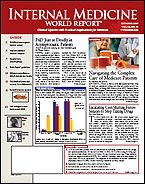Publication
Article
Internal Medicine World Report
Vertebral Fractures Often Ignored, Diminish Men's Quality of Life
Author(s):
Increase Risk for Future Fractures
Increase Risk for Future Fractures
By Daniel M. Keller, PhD
MONTREAL, Canada—Older men often suffer vertebral fractures that cause height loss and deformity, and despite an increasing number of reports, these fractures remain mostly undiagnosed, but they do detract from quality of life (QOL), investigators said at the International Bone and Mineral Society (IBMS) annual meeting.
As part of the Geelong Osteoporosis Study, Julie Pasco, PhD, of the University of Melbourne at Geelong Hospital, Victoria, and colleagues looked at rural and urban populations in southeastern Australia.
Using a random sample of 1148 men (aged 20-93 years) the researchers investigated the incidence of morphometric vertebral fractures and their impact on 3 QOL domains: physical activity, adaptations, and fears.
Vertebral fractures were found in 54 men, 59% of whom had self-reported height loss; 94% of the men were unaware of their fracture. The prevalence of vertebral fracture increased with advancing age (0% for men in their 20s; 15% for men in their 80s).
"We found that more men with vertebral fracture had poor scores in each QOL domain compared with the men without vertebral fracture," Dr Pasco said. Among the men with vertebral fractures, 78% had poor overall QOL compared with 46% of the men with no morphometric vertebral fractures.
"In the age-adjusted analysis, men with vertebral fracture were at about 2.5-fold increased risk of scoring poorly on the physical activity domain, about 2.4-fold more likely to perform poorly on the adaptation section, and about twice as likely to perform poorly on the fears section," he said.
Dr Pasco added that even though vertebral fractures occur in 15% of men aged ≥80 years, skeletal health in men is often overlooked.
Ian Reid, MD
Ian Reid, MD, president of the IBMS and professor of medicine and endocrinology at the University of Auckland, New Zealand, pointed out, "In the last decade we've become aware of the fact that we've sorely neglected the issue of osteoporosis in men."
Dr Reid said that osteoporosis has traditionally been seen as a women's' problem. In addition, "As longevity in both sexes has extended, there are many more men in the at-risk age-group than there were, and all the projections are that that's going to continue to be the case." He noted that about 30% of men will have an osteoporotic fracture after the age of 60.
The diminished QOL in men with morphometric vertebral fractures, he emphasized, "is a reason for taking them more seriously." One fracture puts a person at higher risk for future fractures, with further deterioration of QOL.
These deformities of vertebral bodies are readily apparent when radiologists or internists look at a lateral chest or spine x-ray. Dr Reid advised, "Take these seriously, think about interventions to prevent future fractures when you see these deformities, and maybe even go out looking for them, because they do portend a higher fracture risk in the future."
Risk factors other than advancing age are steroid use, androgen deprivation therapy for prostate cancer, tobacco use or excessive alcohol intake, and a family history of osteoporosis. Men in this study with morphometric vertebral fractures also had lower body weight, reduced height, lower body mass index, and lower bone mineral density.
IMWR
Height loss is a particularly good marker for morphometric vertebral fractures, and simply asking about it can reveal a potential problem (see , December 2006). But loss of height can also be the result of shrinking intervertebral disks without fracture.
Current imaging techniques can readily determine if the loss is from fractures. Dr Pasco advised ordering lateral spine imaging whenever bone density is measured.





